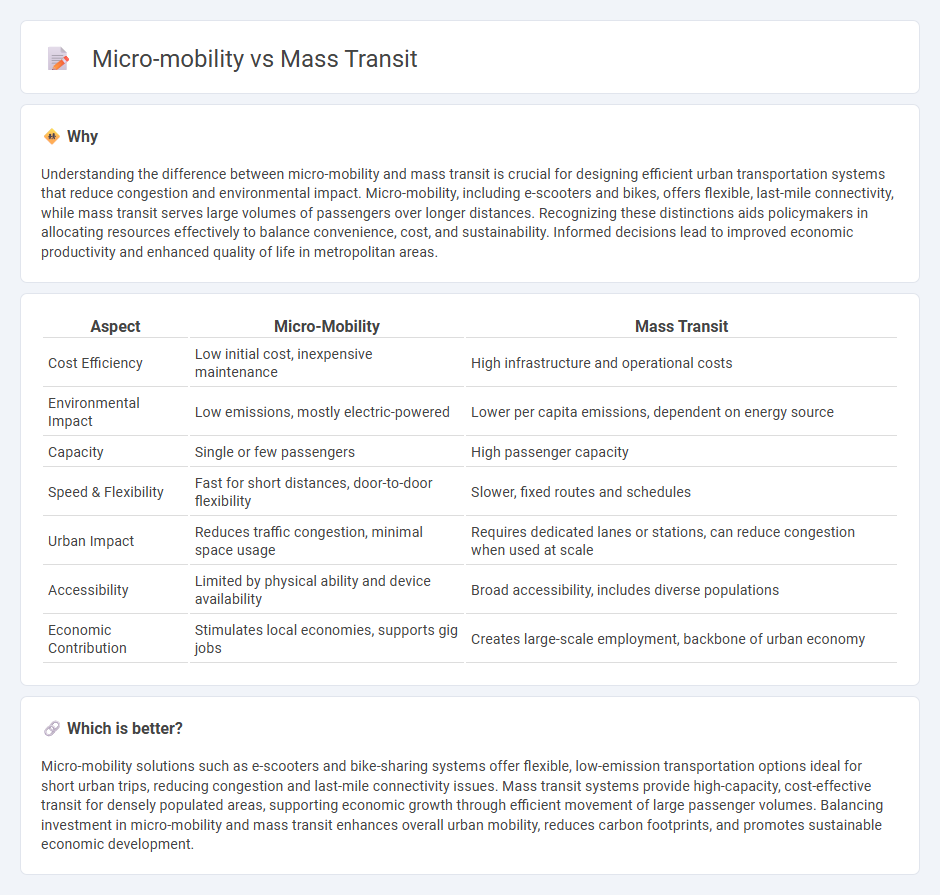
Micro-mobility solutions such as e-scooters and bike-sharing systems offer flexible, cost-effective urban transportation alternatives that reduce congestion and carbon emissions. Mass transit systems, including buses, subways, and trains, provide high-capacity, energy-efficient means of moving large populations across metropolitan areas. Explore the economic impacts and sustainability benefits of micro-mobility versus mass transit in modern city planning.
Why it is important
Understanding the difference between micro-mobility and mass transit is crucial for designing efficient urban transportation systems that reduce congestion and environmental impact. Micro-mobility, including e-scooters and bikes, offers flexible, last-mile connectivity, while mass transit serves large volumes of passengers over longer distances. Recognizing these distinctions aids policymakers in allocating resources effectively to balance convenience, cost, and sustainability. Informed decisions lead to improved economic productivity and enhanced quality of life in metropolitan areas.
Comparison Table
| Aspect | Micro-Mobility | Mass Transit |
|---|---|---|
| Cost Efficiency | Low initial cost, inexpensive maintenance | High infrastructure and operational costs |
| Environmental Impact | Low emissions, mostly electric-powered | Lower per capita emissions, dependent on energy source |
| Capacity | Single or few passengers | High passenger capacity |
| Speed & Flexibility | Fast for short distances, door-to-door flexibility | Slower, fixed routes and schedules |
| Urban Impact | Reduces traffic congestion, minimal space usage | Requires dedicated lanes or stations, can reduce congestion when used at scale |
| Accessibility | Limited by physical ability and device availability | Broad accessibility, includes diverse populations |
| Economic Contribution | Stimulates local economies, supports gig jobs | Creates large-scale employment, backbone of urban economy |
Which is better?
Micro-mobility solutions such as e-scooters and bike-sharing systems offer flexible, low-emission transportation options ideal for short urban trips, reducing congestion and last-mile connectivity issues. Mass transit systems provide high-capacity, cost-effective transit for densely populated areas, supporting economic growth through efficient movement of large passenger volumes. Balancing investment in micro-mobility and mass transit enhances overall urban mobility, reduces carbon footprints, and promotes sustainable economic development.
Connection
Micro-mobility solutions such as e-scooters and bike-sharing programs serve as essential first- and last-mile connectors to mass transit systems, enhancing urban mobility efficiency. Integrating micro-mobility with buses and subways reduces traffic congestion and lowers greenhouse gas emissions by promoting multimodal transport options. This synergy fosters sustainable urban economies through improved accessibility and reduced transportation costs for commuters.
Key Terms
Cost Efficiency
Mass transit systems offer cost efficiency through economies of scale, transporting large numbers of passengers at lower per-capita costs compared to individual travel. Micro-mobility options, such as e-scooters and bike-sharing, reduce last-mile connection expenses and urban congestion, but typically have higher operational costs per trip. Explore detailed analyses to understand which mode best optimizes urban transportation budgets.
Scalability
Mass transit systems like subways and buses can efficiently move thousands of passengers simultaneously, offering high scalability for urban transportation needs. Micro-mobility solutions such as e-scooters and bike-sharing provide flexible, last-mile connectivity but face limitations in scaling due to infrastructure and regulatory constraints. Discover how integrating mass transit and micro-mobility can create scalable, sustainable urban transport solutions.
Last-Mile Connectivity
Mass transit systems efficiently transport large groups across urban areas, but often fall short in covering the last-mile gap from transit stops to final destinations. Micro-mobility options like e-scooters, bikes, and shared electric vehicles provide flexible, cost-effective solutions for bridging last-mile distances, reducing congestion and lowering carbon emissions. Explore how integrating micro-mobility with mass transit enhances seamless urban mobility and accessibility for commuters.
Source and External Links
Public transport - Public transport, also called mass transit, refers to forms of transportation available to the general public that operate on fixed schedules, routes, and fares, including buses, trams, trains, subways, and ferries, providing access for people without private vehicles, the elderly, disabled, and more.
Mass transit | Definition, History, Systems, Examples, & Facts - Mass transit is the movement of people within urban areas by group travel technologies like buses and trains, evolving from animal-drawn vehicles to electric trains and motor buses, shaping city development with large-capacity and fixed-route systems.
Federal Transit Administration History | FTA - The U.S. federal transit program, initiated by the Urban Mass Transportation Act of 1964, has evolved to support and modernize mass transit systems nationwide with significant funding increases, including recent investments exceeding $100 billion to expand and improve public transportation.
 dowidth.com
dowidth.com